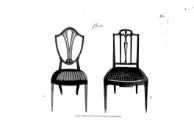A global chair
Can we retrace the design of this particular chair? As mentioned prior, the chair is made after Hepplewhite design. George Hepplewhite was a famous English furniture maker during the 18th century. The British Hepplewhite factory had published a guide on its designs in the late 18th century. Van Braam Houckgeest likely acquired a version of this work, which was full of the company’s designs, in the years before he left.
Furniture that belongs to the Hepplewhite school is not necessarily made by George Hepplewhite and his factory; instead, many other craftsmen made furniture resembling Hepplewhite’s designs. These craftsmen made high quality, elegant furniture for the higher class, and lower quality furniture for the middle class.
Chair production was no small business. Chairs such as this one are cleverly constructed: all components, such as the armrests, the back, and the legs, are manufactured individually. When constructing the chair, the components simply slide into the designated holes. The armrests, for instance, fit into the back of the chair due to clever woodworking, which made making adjustments to the chair relatively easy.
This partially explains why we cannot find this exact chair in Hepplewhite’s guide. With the help of Godelieve van Wees, Sinologist, furniture restaurator, and owner of Le Signe Violet in Leiden, we will look closely at a few points on the chair to find out more.

